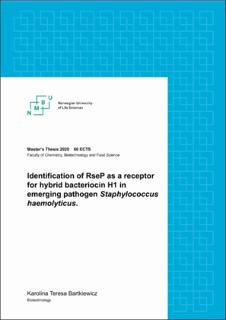| dc.contributor.advisor | Diep, Dzung Bao | |
| dc.contributor.advisor | Mathiesen, Geir | |
| dc.contributor.advisor | Kristensen, Sofie S. | |
| dc.contributor.author | Bartkiewicz, Karolina Teresa | |
| dc.contributor.editor | Mathiesen, Geir | |
| dc.date.accessioned | 2020-11-27T11:43:23Z | |
| dc.date.available | 2020-11-27T11:43:23Z | |
| dc.date.issued | 2020 | |
| dc.identifier.uri | https://hdl.handle.net/11250/2689929 | |
| dc.description.abstract | Staphylococcus haemolyticus is an emerging pathogen which may transfer multi-drug resistance genes to highly virulent Staphylococcus species. S. haemolyticus is a biofilm-producing bacterium and one of the most frequent isolates of nosocomial infections associated with implanted medical devices, such as catheter. To this date there are only a few therapeutic options that can stop this bacterium, including the last resort antibiotic, vancomycin and teicoplanin, for which resistance have already been reported. This study shows that an alternative antimicrobial agent has great potential to inhibit this pathogen. Hybrid bacteriocin H1 consisting of N-terminal part of EntK1 and C-terminal part of EntEJ97, exhibits strong activity against S. haemolyticus. A combination of bacteriocin H1 with garvicin KS displays greater antibacterial activity against S. haemolyticus and is promising in inhibiting resistant mutants, which appear to be the main problem in H1 application.
The aim of this study was to reveal the nature that indicates the specificity of H1 toward S. haemolyticus. The Zn-dependent protease RseP in S. haemolyticus was established as a receptor for bacteriocin H1. This is based on the fact that the S. haemolyticus gene rseP was heterologously-expressed in naturally H1 resistant Lactobacillus plantarum WCFS1 and the resulting transformant became highly susceptible to H1.
RseP isolated from resistant mutants were sequenced in order to verify the nature of the bacterial resistance to H1. Interestingly, obtained data showed intact rseP gene in all mutants. WGS analysis was a conclusive step in this study and indicated mutation in a putative Ecs ABC transporter. Similar discoveries from previous investigations suggest the influence of Ecs transporter on RseP activity at protein level. One might speculate that Ecs protein inhibits RseP interaction with bacteriocin by blocking its activity. However, the results of this study do not allow for specific conclusions on correlation between Ecs and RseP. Further studies of between RseP and Ecs interaction with bacteriocin H1 are required. | en_US |
| dc.description.abstract | Staphylococcus haemolyticus kan overføre gener for multi-resistansen til sterkt virulente Staphylococcus arter. S. haemolyticus er en biofilm produserende bakterie og et av de hyppigste isolatene i nosokomiale infeksjoner, og er ofte forbundet med implantert medisinsk utstyr som for eksempel kateter. Til dags dato er det bare noen få terapeutiske alternativer som kan hindre denne bakterien. Dette inkluderer også bruk av antibiotika som en «last resort», selv bakterier som er resistente mot en slik behandling allerede er rapportert. Denne studien viser at et alternativt antimikrobielmiddel har stort potensiale for å hemme dette patogenet. Hybrid bakteriosin H1 består av N-terminal part av EntK1 og C-terminal part av EntEJ97 og viser sterk aktivitet mot S. haemolyticus. En kombinasjon av de to lederløse bakteriosinene H1 og garvisin KS utviser stort antibakteriell aktivitet mot S. hamolyticus og er lovende for å hemme resistente mutanter, som ser ut til å være hovedproblemet i H1 applikasjonen.
Målet med denne studien var å avsløre naturen som angir spesifisiteten til H1 mot S. haemolyticus. Den Zn-avhengige proteasen RseP i S. haemolyticus ble etablert som reseptor for bakteriosin H1. Detter er basert på det faktum at S. haemolyticus - genet rseP ble heterologt uttrykt i naturlig H1-resistent Lactobacillus plantarum WCFS1 og den resulterende transformanten ble svært sensitiv til H1.
RseP isolert fra resistente mutanter, ble sekvensert for å verifisere naturen av bakteriell resistans mot H1 og variasjoner i fenotype ved stressrespons. Interessant nok, var rseP i alle mutanter. WGS analysen var et avgjørende trinn i dette arbeidet, og indikerte delesjoner i Ecs ABC transporter. Tilsvarende funn fra tidligere studier antyder en påstått effekt av Ecs transporter på RseP-aktivitet på proteinnivå. Man kan spekulere at Ecs protein hemmer RseP interaksjon med bakteriosin H1 ved å blokkere dets aktivitet. Resultatene fra denne studien tillater ikke konkrete konklusjoner om sammenheng mellom Ecs og RseP. Videre studier om interaksjonen mellom RseP og Ecs med bakteriosin H1 er nødvendig | en_US |
| dc.language.iso | eng | en_US |
| dc.publisher | Norwegian University of Life Sciences, Ås | en_US |
| dc.rights | Attribution-NonCommercial-NoDerivatives 4.0 Internasjonal | * |
| dc.rights.uri | http://creativecommons.org/licenses/by-nc-nd/4.0/deed.no | * |
| dc.title | Identification of RseP as a receptor for hybrid bacteriocin H1 in emerging pathogen Staphylococcus haemolyticus | en_US |
| dc.title.alternative | Identifisering av RseP som reseptor for hybrid bakteriocin H1 i voksende patogen Staphylococcus haemolyticus | en_US |
| dc.type | Master thesis | en_US |
| dc.source.pagenumber | 112 | en_US |
| dc.description.localcode | M-BIOTEK | en_US |

